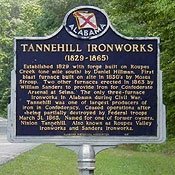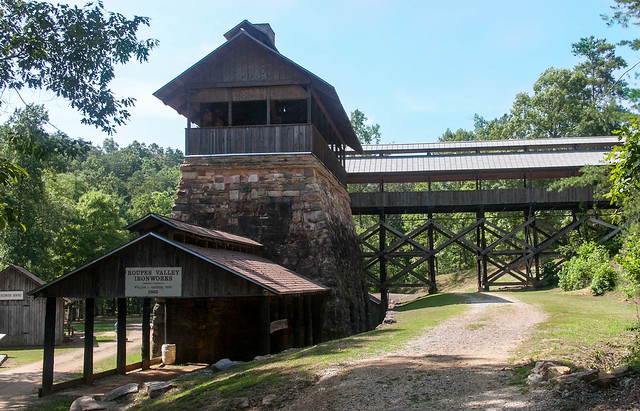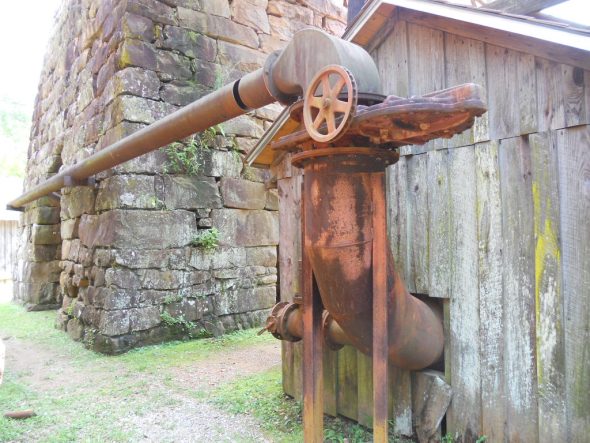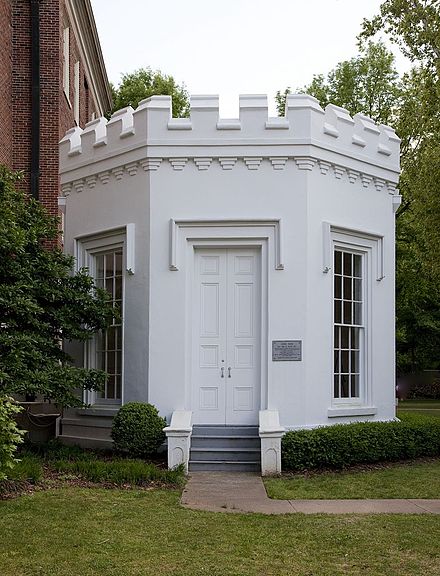The Tannehill Furnaces Played a Major Role in The Civil War
The Tannehill Furnaces are the center point feature of the Ironwork's Historical National Park that is located in Tuscaloosa County in the unincorporated town of McCalla.
McCalla is about 40 miles east of Tuscaloosa.
 The Tannehill Furnaces State Park Sign
The Tannehill Furnaces State Park SignThese historic furnaces are listed in the National Register of Historic Places, and during the Civil War, they played a major role.
The History of the Tannehill Furnaces
 The Ironworks National Park in McCalla Alabama
The Ironworks National Park in McCalla AlabamaDuring the Civil War, the Tannehill Furnaces was a major supplier of iron for the Confederate army, and they have an interesting history.
Ironmaking at the Tannehill Furnaces first began with the construction of the Bloomery Forge that was started by Daniel Hillman Sr., in the year 1830.
These historic furnaces were built in the years 1859 to 1862 by the famed iron-master Moses Stroup.
There were three major blast furnaces, and during its peak production, they were producing over 22 tons of pig iron each and every day.
This pig iron was a vital source of war materials for the Confederate Army, and these much-needed resources were shipped to the Naval Gun Works and Arsenal in Selma.
Once at Selma, they were converted into the much-needed arms for the Confederate army.
However, these furnaces also had another name; the Roupes Valley Iron Company.
The Tannehill Furnaces also played a very early role in the later development of the city of City Birmingham’s iron and steel industry.
There was an early experiment at this site in the year 1862, which showed that the “red iron” could indeed be utilized in any of Alabama’s blast furnaces.
This test was sponsored by the South and North Railroads and led to the ironwork's foundries in Birmingham after the war.
Mr. Hillman, who was originally from Pennsylvania, built a test “bloomery forge” that was located on the banks of the Roupes Creek in the year 1830.
It was at this location that he discovered extremely rich deposits of brown ore that were used to make pig iron.
However, he died a couple of years later, and Ninian Tannehill took over the operation.
He had slaves that cut sandstone rocks and then stacked together to form three tall furnaces, between the years 1859 to 1863.
It was here that the Tannehill Furnaces were born.
The industrial center that grew as a result of the Tannehill Furnaces, worked feverishly to keep them going.
Trees from the near hills were made into charcoal that fed these hungry beasts, and the nearly Roupes Creek was unitized by a steam engine for more support.
This steam engine was powered by huge blowing machines that not only heated the fires; they helped to melt the ore.
From here the ore was formed into “pig iron” and once produced, was shipped to Selma.
Once there, it was made into every kind of ordnance the military needed, as well as ovens, pots, and skillets.
However, all of this came to a crashing end by the Union armies.
The U.S 8th Iowa Calvary stormed the area on March 31, 1865, and then attacked and burned the historic site down during what became known as “Wilsons Raid”.
The remains of the Tannehill Furnaces were named as an American Society for Metals Historical Landmark in the year 1994.
These remains are located 12 miles south of the town of Bessemer Alabama, near the southern end of the Appalachian Mountains.
Tannehill Furnaces Museum
 Pictures of the Ironworks National Park Exhibits
Pictures of the Ironworks National Park ExhibitsThe Tannehill Furnaces Museum, also known as the Iron and Steel Museum of Alabama, is located in a Historic State Park bearing the same name in McCalla.
It was first opened in the year 1981 and covers over 13,000 square feet.
It features the process utilized in the 19th century to make iron and features simulated belt driven machines.
It also features several of the products used during these times, and it also has one of the best collections of Confederate ordinances.
These include actual shells that were used by the Confederate Army.
The Tannehill Furnaces Museum also shows graphically how this iron was made during the Civil War.
Some of the displays that are featured include very rare CS artillery projectiles, which were produced in Selma along with several different weapons.
It was opened in the year 1981 but had a major renovation in 2005 to make room for several new exhibits.
These new exhibits include one of the oldest steam engines in the country, including an 1835 Dotterer engine.
This engine was part of a collection that was acquired by Henry Ford in the 1920’s and is similar to the blast engine once used at the Tannehill Furnaces.
There are also displays that feature an 1860’s machine shop that includes a Townsend cannon lathe dating to the year 1864.
There are also various interactive displays that actually make you feel like you are in this environment, and it also has a 25-seat theatre.
Behind the museum, visitors can also go to the May Plantation Cotton Gin, dating back to 1858, as well as a heavy industrial building.
This building is the home of several Birmingham steel mill artifacts.
References
http://www.encyclopediaofalabama.org/article/h-1616

Alabama Gift Store
Numerous Items for You and Your Family to Enjoy
See it here at the Gift Store
Copyright 2019-2023 Alabamabackroads.com
All Rights Reserved

















